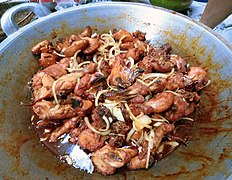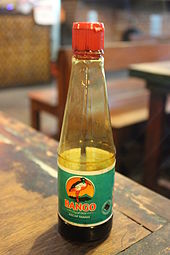Sweet soy sauce
-
 Media: Sweet soy sauce
Media: Sweet soy sauce
Sweet soy sauce (Indonesian: kecap manis) is a sweetened aromatic soy sauce, originating in Indonesia, which has a darker color, a viscous syrupy consistency, and a molasses-like flavor due to the generous addition of palm sugar or jaggery.[1] Kecap manis is widely used with satay. It is similar to, though finer in flavor than, Chinese Tianmian sauce (tianmianjiang).[1] It is by far the most popular type of soy sauce employed in Indonesian cuisine and accounts for an estimated 90 percent of the nation's total soy sauce production.[2]
Ingredients
Compared to kecap asin, the mildly salty regular soy sauce, the sweet soy sauce has a slightly thicker consistency and tastes much sweeter. This condiment is made from a fermented paste of boiled black soybeans, roasted grain, salt, water, and Aspergillus wentii mold, to which palm sugar is added.[3] The strong sweet taste is contributed by a generous amount of palm sugar — the sauce may contain up to 50 percent gula merah or gula jawa (palm sugar jaggery). Indonesian sweet soy sauce is often enriched with spices, including star anise, cinnamon, black pepper, coriander, and clove.[2]
Uses
Kecap manis is an essential sauce in the Indonesian pantry. It is used to add a pleasantly mild sweet and umami flavor to most popular Indonesian dishes, including nasi goreng, mie goreng, kwetiau goreng, ayam kecap (roasted chicken), babi kecap (braised pork), semur beef stew, and ketoprak. It is also a popular marinade for grilled dishes, such as satay, ayam bakar (grilled chicken), and ikan bakar (grilled fish). Sweet soy sauce is also a popular dipping sauce, mixed with chopped shallot and bird's eye chili and served as a dipping sauce for tahu goreng (fried tofu). Steamed rice topped with fried egg and drizzled with sweet soy sauce was a popular meal among Indonesians in the 1990s and 2000s, especially children. In Eastern Indonesia, sweet soy sauce is used as the ingredient of colo-colo dipping sauce, although traditionally this Maluku sauce uses black-colored rendered coconut oil residue.
- Various sweet soy sauce recipes
- Gurame bakar (grilled gourami) served with sweet soy sauce as both marination and dipping sauce
-
 Ayam kecap, chicken poached in sweet soy sauce
Ayam kecap, chicken poached in sweet soy sauce - Semur daging, beef and potato stew in sweet soy sauce
-
 Babi kecap, pork simmered in sweet soy sauce
Babi kecap, pork simmered in sweet soy sauce
Brands

In Indonesia, there are large numbers of sweet soy sauce brands. Kecap manis is traditionally a small-scale home industry. However there are a handful of brands that are widely distributed throughout Indonesia and regionally, such as kecap manis ABC,[4] Kecap Bango [id],[3] Indofood, and Sedaap.[5][6]
Besides the national brands, there are numerous regional brands, such as Ikan Lele in Pati, Mirama in Semarang, Orang Jual Sate in Probolinggo, Siong Hin (SH) in Tangerang, Tomat Lombok in Tegal, etc.[7] More or less, there are a hundred regional brands of kecap manis.[8]
Some brands distribute widely in the Netherlands like Conimex, Inproba, Kaki Tiga, and "A" Trade Mark.[citation needed]
Substitutes
Sweet soy sauce is widely available in Indonesian marketplaces, warungs, minimarkets, supermarkets, toko, and Asian grocery stores worldwide. However, it is quite hard to find in most parts of Europe (except for the Netherlands, UK, and Germany) and also quite scarce in the Americas. Sweet soy sauce can be made from regular soy sauce. Regular soy sauce mixed with brown sugar, added with a trace of molasses, can serve as a substitute for sweet soy sauce.[9]
See also
- Dark soy sauce
- Soup soy sauce
- List of condiments
- List of fermented soy products
- List of sauces
- Sweet bean sauce
- Teriyaki sauce
- Ketchup
References
- ^ a b William Shurtleff; Akiko Aoyagi (2011). History of Tempeh and Tempeh Products (1815-2011): Extensively Annotated Bibliography and Sourcebook. Soyinfo Center. p. 618. ISBN 9781928914396. Retrieved 15 February 2016.
- ^ a b William Shurtleff; Akiko Aoyagi (2010). History of Soybeans and Soyfoods in Southeast Asia (13th Century To 2010): Extensively Annotated Bibliography and Sourcebook. Soyinfo Center. p. 537. ISBN 9781928914303. Retrieved 15 February 2016.
Kecap manis Indonesian cuisine.
- ^ a b "Sejarah Bango". Kecap Bango (in Indonesian).
- ^ "ABC Kecap Manis Rasa Mantap". Heinz ABC (in Indonesian).
- ^ "Kecap Sedaap". Wings Food (in Indonesian). Archived from the original on 2020-02-24. Retrieved 2016-02-15.
- ^ "Kecap Sedaap". Wings Food (in Indonesian). Archived from the original on 2023-08-21. Retrieved 2023-08-21.
- ^ "Daftar 7 Kecap Lokal Favorit di Indonesia". kumparan.com (in Indonesian). kumparanfood. 20 October 2018. Retrieved 23 August 2022.
- ^ Denisa (28 January 2015). "Berburu Botol Kecap Hingga ke Pelosok Nusantara". merdeka.com (in Indonesian). Retrieved 23 August 2022.
- ^ "Ketjap Manis". Food.com.
External links
- Ketjap Manis recipe
- v
- t
- e

dishes
condiments
| Soy sauce based | |
|---|---|
| Pastes | |
| Fermented bean |
| Phytoestrogens | |
|---|---|
| Globulins (proteins) |
|
| PHAs (lectins) |
|
| Enzymes | |
| Trypsin inhibitors |
|
| Other |
- 8th Continent
- Alpro
- Boca Burger
- Gardenburger
- Kikkoman
- Morningstar Farms
- Mr Bean
- Plamil Foods
- Silk
- So Good
- Tofutti
- Vitasoy
- Yamasa
- Yeo Hiap Seng
- Diet for a Small Planet
- Kikkoman Soy Sauce Museum
- William Shurtleff and Akiko Aoyagi
- Yuasa, artisan town of historic soy sauce distilleries
 Category: Soybeans
Category: Soybeans


















